Ferruccio Lamborghini was the son of a farmer, but he was more interested in machinery than in agriculture. He made his name -- and more importantly his fortune -- making tractors, first converting discarded military vehicles and later producing purpose-built machines under his own name. By the early 1960s Lamborghini had branched out into heating and air-conditioning equipment, and the success of these ventures meant Ferruccio was wealthy enough to drive Italy’s ultimate cars, Ferraris.
Not that Lamborghini was always impressed with Maranello’s cars, nor their autocratic creator. One story suggests that Lamborghini’s Ferrari had a noisy gearbox. When he complained, Enzo replied that Lamborghini should stick to tractors and let him worry about sports cars. Another tale is that Ferruccio spotted components on his Ferraris that he was also using on his tractors, but that spares cost three times as much - and he realised that there was money to be made building sports cars.
Whether either story is true is open to doubt, but it’s certainly true that Lamborghini decided to take on Ferrari at its own game.
Ferrucio's first anti-Ferrari
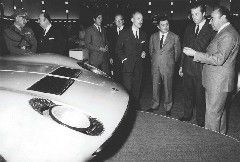 The Miura's launch with Ferruccio Lamborghini (third from right) |
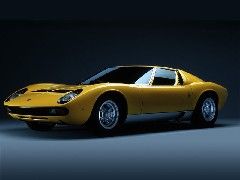 Lamborgini Miura (above and below) |
|
|
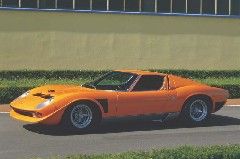 Ill-fated Lamborgini Jota |
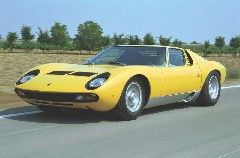 Miura SV (above and below) |
|
|
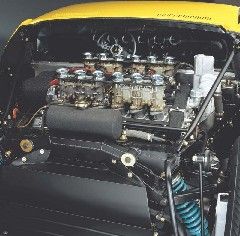 Engine from the SV |
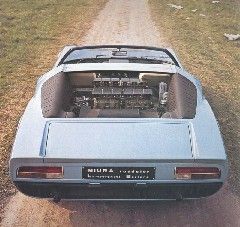 Roadster (above and below) never made it into production |
|
|
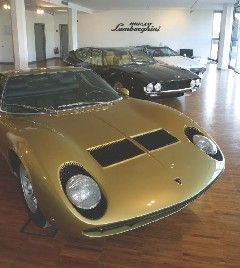 Miuras are wasted in museums... |
Lamborghini’s first car began to take shape towards the end of 1962, designed by a group of ex-Ferrari engineers. Giotto Bizzarrini was responsible for the V12 engine, Giampoalo Dallara and Giampaolo Stanzani looked after the chassis and the styling was initially entrusted to Franco Scaglione. But the first show car’s wild shape was given a rather cool reception, and the definitive 350GT production car carried bodywork restyled by Carrozzeria Touring of Milan.
Lamborghini built a new factory at Sant’Agata, just outside Bologna, and by 1964 production of the 350GT was in full swing.
It was soon followed by the 4.0-litre 400GT and a succession of prototypes and show cars which sprang from the fertile imaginations and boundless enthusiasms of the young engineers Dallara and Stanzani. The wildest of these projects ditched the steel-tube frame and front engine of conventional GT cars in favour of a monocoque built up from sheet steel, with its V12 engine mounted transversely behind the cockpit. It was a flight of fancy by the engineering team, inspired by the then-new Ford GT40 racing car, but when Lamborghini saw it he sanctioned a production version - it would be good publicity, he said, though clearly they would never sell more than 50 of them...
The chassis made its first public appearance at the Turin show in 1965, where pundits queued up to opine that Lamborghini would never put it into production. They were wrong. Barely four months later, in the Spring of 1966, Sant’Agata unveiled a production-ready version which now had an eye-catching body designed by Bertone’s new styling chief, Marcello Gandini. It had also acquired a name, Miura, after the famous Spanish breeder of fighting bulls, Don Antonio Miura. And it stole the show.
In every area the Miura seemed head and shoulders above its competition, which meant the red cars from Maranello. Its space-age looks were enough to stop bystanders in their tracks as you drove by, and if you stopped to lift the huge front and rear lids you could count on a crowd gathering.
Technically, it was very advanced: the mid-engined layout was sweeping motor racing, and like the 350GT and 400GT before it, the Miura had all-independent suspension in an era when some Ferraris still sported rigid rear axles. Bizzarrini’s 3.9-litre four-cam V12, developing a claimed 350bhp, was fitted in a unit with its transmission, the engine and gearbox sharing a common oil system. There was talk of a top speed of 180mph: the reality was ‘only’ a little over 170, but even that was fast enough...
Orders streamed in, soon surpassing Lamborghini’s predictions and quickly making the Bolognese company the hottest property in sports cars. Further new models -– the Islero GT and Espada four-seater -- were introduced to capitalise on the publicity generated by the Miura, and a Miura roadster prototype was shown to the public at the Brussels show in 1968, though it never made it into production.
Lamborghini wisely chose to consolidate, concentrating on getting the Miura and its stablemates to waiting customers, while behind the scenes work began on the important new ‘mid market’ Lamborghini, the P250 Urraco which would debut in 1970.
Lamborghini needed to do little to the Miura to keep orders rolling in, but a revised Miura S was introduced later in 1968. Though it looked much the same as before there were many detail improvements under the skin, including a claimed 20bhp power hike.
Considerably more power was available from the Jota, a racing machine based loosely on the Miura. Developed by New Zealander Bob Wallace, the Jota carried a 440bhp V12 in a revised, lightweight chassis, clothed in a Miura-style body with a prominent front air dam. Weighing in at just 890kg the Jota could reportedly despatch the 0-60mph sprint in well under four seconds, but the car’s performance was to hasten its demise. The Jota was sold on by the factory, and shortly after it was completely destroyed in a crash in Brescia.
But the idea of a faster Miura lived on, and the result was the launch in 1971 of the Miura SV incorporating many of the lessons learned with the Jota. There were wider tyres, the suspension geometry was revised, the chassis was built from heavier-gauge steel and there were individual oil systems for the engine and gearbox. Power rose to 385bhp, making the SV the quickest of the Miuras as well as the strongest and best handling. A handful of SVs were given some of the more extreme Jota modifications by the factory, and were known as SVJs.
By then, though, the biggest news at Lamborghini was no longer the Miura. Instead the Sant’Agata factory had a brand new supercar - even faster and even more outlandish than anything it had produced before. At the Geneva motor show in 1971, alongside the brand new Miura SV, there it sat: the prototype LP500 Countach.